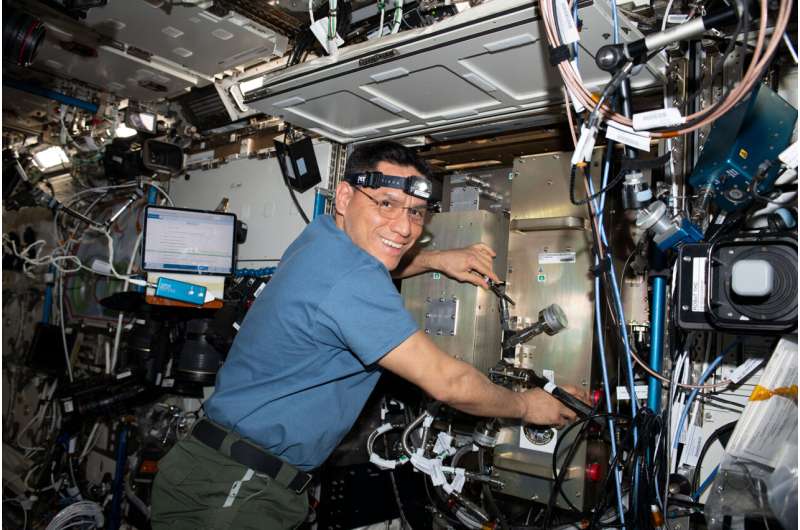
After a decade of preparation and two years of active experiments in space, a facility that Purdue University and NASA’s Glenn Research Center in Cleveland designed, built and tested has completed its test campaign on the International Space Station.
The Flow Boiling and Condensation Experiment (FBCE), led by Purdue professor Issam Mudawar, gathered vital data for engineering innovations to help astronauts travel farther into space and conduct long-duration missions on the moon or Mars. The data will also support the design of future spacecraft propulsion, thermal management systems, in-space refueling and vapor compression heat pumps for planetary bases.
“We were asked to create an experiment to test flow boiling in microgravity, and I’m thrilled to see that we’ve delivered in a big way,” said Mudawar, the Betty Ruth and Milton B. Hollander Family Professor of Mechanical Engineering and FBCE’s principal investigator. “The amount of data coming out of the FBCE is just absolutely enormous, and that’s exactly what we want.”
Mudawar’s space-based experiment tackles a simple question: How do we keep future vehicles and facilities cool in space’s harsh environment? For example, the moon’s surface fluctuates wildly between minus 410 degrees and 250 degrees Fahrenheit; to create a human habitat there, reliable thermal management will be essential.
Traveling farther into space requires cryogenic fuel depots, but the flow physics of cryogenic liquids in microgravity haven’t been fully understood. Even future propulsion systems, such as nuclear fission or Rankine cycle heat engines, will also require efficient cooling systems capable of operating in a zero-gravity environment.
For all these reasons, NASA solicited research proposals on the topic and selected a proposal submitted by Mudawar, who is one of the most cited researchers on flow boiling and condensation, and Glenn’s Mojib Hasan.
In flow boiling, heat is removed by flowing a liquid that then boils, phase-changing into a gas, and then later condensing back into a liquid. While this efficient thermal management solution has been studied in-depth on Earth, no one knew if it was feasible in space.
“We have developed over a hundred years’ worth of understanding of how heating and cooling systems work in Earth’s gravity,” Mudawar said, “but we haven’t known how they work in weightlessness.”
Enter the FBCE, which started operating on the space station in 2022. About the size of a refrigerator, FBCE contains two Purdue-designed test modules—one for flow boiling and one for condensation—integrated with a fluid system that Purdue researchers and NASA Glenn designed together. NASA Glenn built the fluid system along with avionics modules. Sitting in the space station’s Fluids Integrated Rack, the fluid system enables researchers to conduct space station experiments autonomously from the ground.
“The FBCE experiments are crucial in two ways,” Mudawar said. “Not only do they generate fundamental data that would be difficult for us to gather on Earth, but they also serve to validate theoretical models that we have spent years developing. Once the models are validated, it becomes possible for NASA to more accurately predict the fluid physics of lower-gravity environments, such as the moon or Mars.”

Boiler up
Mudawar started this project in 2011 when NASA selected his proposal after a decadal survey from the National Academies emphasized the need for this research.
“Every 10 years, the National Academies conduct a survey that advises NASA what specific aspects they should focus on,” Mudawar said. “This report indicated a lack of fundamental models of how fluids behave in microgravity. That’s when I began work with NASA Glenn to create an experimental facility to study fluid flow and phase change in space.”
The first prototype FBCE flew on parabolic airplane flights with Zero Gravity Corp. (ZERO-G). Purdue students and NASA Glenn-qualified operators conducted experiments on that flight during 15-second periods of microgravity. After promising results and years of hardware development, testing and flight qualification, the final version of the facility came together at NASA Glenn.
After passing NASA’s design, safety and readiness reviews, FBCE’s flow boiling module was launched to the space station in August 2021 and began operations in early 2022. Last August, the condensation module of FBCE launched, replacing the flow boiling module. Purdue completed its test campaign in July.
The mountains of data gathered from FBCE’s experiments will form the basis of fundamental models and future research for years to come.
“This is among NASA’s largest and most complex experiments for fluid physics research,” Mudawar said. “We have published more than 70 papers on reduced gravity and fluid flow since the project’s inception and even contributed to the most recent National Academies decadal survey based on our findings. Collectively, these papers are really almost like a textbook for how boiling and condensation works in space.”
Cool future
While the Purdue test campaign has ended, FBCE isn’t going anywhere. The facility will remain on the space station for other researchers who want to experiment with fluid physics in space.
“My original proposal established that FBCE would eventually become a national resource,” Mudawar said. “Other investigators have already started using it since our campaign ended. It’s my hope that the data coming from FBCE will help establish the science of cooling spacecraft for years to come.”
Provided by
Purdue University
Citation:
Completed experiments on International Space Station to help answer how boiling and condensation work in space (2024, September 26)
retrieved 27 September 2024
from https://phys.org/news/2024-09-international-space-station-condensation.html
This document is subject to copyright. Apart from any fair dealing for the purpose of private study or research, no
part may be reproduced without the written permission. The content is provided for information purposes only.


